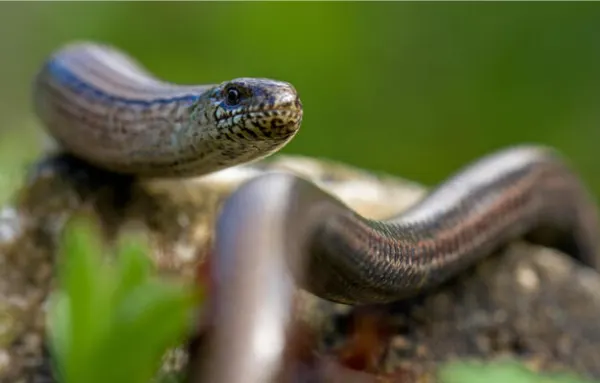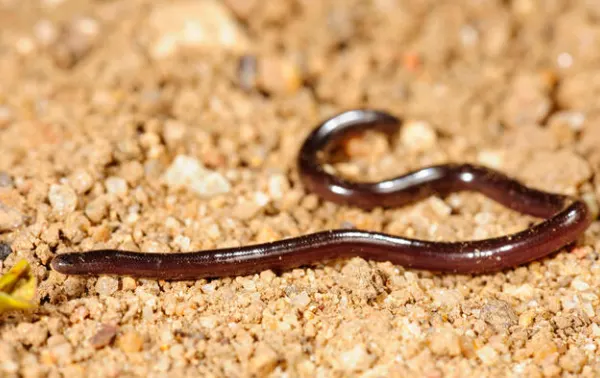Blind snakes might look like earthworms, but these elusive reptiles are far more intriguing than they first appear. With their mysterious subterranean lifestyle and unique adaptations, blind snakes are a hidden gem in the reptilian world. In this blog post, we’ll uncover the secrets of blind snakes, exploring their classification, physical traits, diet, habitat, and much more. Plus, we’ll answer some burning questions about these enigmatic creatures. Dive into the captivating world of blind snakes with us!

Table of Contents
Unveiling the Blind Snake: An Overview
Blind snakes belong to the superfamily Typhlopoidea and are found across the globe, from the rainforests of South America to the deserts of Africa. Their name, “Typhlopidae,” means “blind eye” in Greek, a nod to their rudimentary vision. Despite their name, blind snakes aren’t actually blind; they simply have very limited eyesight that’s adapted for their underground lifestyle.
Spotting the Blind Snake: Physical Features
These fascinating reptiles sport elongated, cylindrical bodies that make them resemble worms. Typically ranging from 5.5 to 12 inches in length, some species can grow up to 3.3 feet. Their smooth, shiny skin is usually gray or pink, enhancing their worm-like appearance. Notably, blind snakes have a distinctive horned scale on their tail, which helps in defense against predators.
Fun Fact: Despite their snake-like body, blind snakes are non-venomous and completely harmless to humans!
Where Do Blind Snakes Call Home?
Blind snakes are masters of concealment. They thrive in tropical regions around the world, digging into soft soils or hiding under leaves and rocks. Their preference for humid environments means they are rarely seen unless they surface during or after heavy rain. They are especially prevalent in tropical Africa, Asia, and the Americas, and can even be found in parts of Europe and Oceania.
Pro Tip: If you’re trying to spot a blind snake, look after a rainstorm or in damp, leaf-laden environments!
What’s on the Menu?
Blind snakes have a taste for small, underground invertebrates. Their diet primarily consists of ants and termites, including their larvae and eggs. Equipped with a highly sensitive sense of smell, blind snakes can locate ant hills and termite mounds with impressive accuracy. Their jaws are specially adapted to consume these small creatures quickly and efficiently.
Did You Know? Some blind snake species, like the Brahminy blind snake, can reproduce without fertilization, a fascinating example of parthenogenesis!
The Secret Life of Blind Snakes
Blind snakes are largely solitary and elusive. They spend most of their lives underground, emerging only occasionally to find food or during the breeding season. Their shy nature means they prefer to avoid human contact, often curling into a ball and secreting a foul-smelling mix of slime and feces when threatened.
Quirky Behavior: Despite their non-aggressive nature, blind snakes can defend themselves with a unique defensive tactic involving a smelly secretion!
Meet the Stars of the Blind Snake World
Here are some standout blind snake species:
- Brahminy Blind Snake: Found in Southeast Asia and Florida, this species is dark-colored and reaches about 7 inches in length.
- Texas Blind Snake: Known as the Texas thread snake, this brown snake ranges from 3 to 13 inches and is native to Texas.
- Western Blind Snake: Bright pink and tiny, this species is commonly found in California.
Conservation Status: A Mixed Bag
Blind snakes’ conservation status varies. While many are classified as “Least Concern” by the International Union for Conservation of Nature (IUCN), some species face threats. Habitat loss and environmental changes have led to the decline of certain species, such as the critically endangered Madagascar blind snake.
Conservation Tip: Protecting natural habitats and addressing climate change are crucial for the survival of these fascinating reptiles.
Blind Snake FAQs
1. Are blind snakes venomous?
No, blind snakes are non-venomous and pose no threat to humans. They are harmless and rely on their size and habitat for protection.
2. Can I keep a blind snake as a pet?
Blind snakes are occasionally kept by herpetoculture enthusiasts, but they are not commonly available. They are low-maintenance and not particularly interactive, making them less popular as pets.
3. Are blind snakes rare?
Blind snakes are not rare globally. They are widespread in tropical regions, though their subterranean lifestyle makes them less visible. They are most often found after rain or in damp, leaf-laden areas.
4. Why are they called blind snakes?
The term “blind snake” refers to their poorly developed eyesight. These snakes have minimal vision, adapted to their dark, subterranean environment.
5. How do blind snakes hunt?
Blind snakes hunt primarily by scent. They follow the trails of ants and termites to locate and consume their prey. Their small mouths are perfectly suited for their diet of tiny invertebrates.
6. Are blind snakes aggressive?
No, blind snakes are generally shy and non-aggressive. They prefer to avoid confrontation and will use defensive behaviors if threatened.

7. Where do blind snakes live?
Blind snakes inhabit tropical regions worldwide, except Antarctica. They are typically found underground or in leaf litter, where they remain hidden from predators and human observers.
8. What do blind snakes eat?
Blind snakes primarily feed on ants and termites, including their larvae and eggs. Their diet is well-suited to their subterranean lifestyle.
To sum up, blind snakes offer a captivating glimpse into the adaptability and diversity of the reptilian world. Their unique adaptations and behaviors highlight the wonders of evolution and the complexity of life beneath the surface. Next time you encounter a blind snake—or perhaps just learn about them—appreciate the hidden marvels of these secretive creatures.
- Enchi Ball Python: A Unique and Stunning Morph of Python regius - March 27, 2025
- Emerald Tree Monitor: The Enigmatic Green Guardian of the Rainforest - March 26, 2025
- The Egyptian Cobra (Naja haje): A Fascinating Serpent - March 25, 2025
